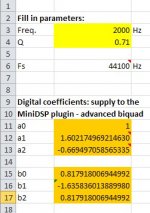Hi, I tried to ask on the miniDSP forum and the response to the post was that their spam detector immediately decided I was a spammer and banned my IP, rather than post.
Anyway - I thought I'd ask here if anyone can shed light on it.
I was looking for some IIR coefficient calculator code - ideally to include Linkwitz Transformm, which is why I like the sheet, in principle.
However, there seems to be significant non-correlation of the numerator coefficients that I get out of the advanced biquad calculator sheet compared to other calculators, specifically:
- https://www.easycalculation.com/physics/electromagnetism/biquad-calculator.php
- Biquad calculator v2 | EarLevel Engineering
- https://community.freescale.com/docs/DOC-100240
The freescale app references RBJ directly, but it doesn't come with source. The other two have JavaScript on the page.
I tried:
- 44.1kHz
- 2nd order high pass
- Q 0.71
- 0 gain
I got:
All-digital-coefs (HPF, Z1:Z3):
b0 0.979837613667748
b1 1.959675227335500
b2 0.979837613667748
a1 -1.60217496921463
a2 0.66949705856534
easycalculation:
a0: 0.8179
a1: -1.6358
a2: 0.8179
b1: -1.6022
b2: 0.6695
earlevel:
a0 = 0.8179180069449915
a1 = -1.635836013889983
a2 = 0.8179180069449915
b1 = -1.602174969214631
b2 = 0.669497058565335
BiquadFilterView (freescale):
b[0] = 0.817918006944992
b[1] = -1.63583601388998
b[2] = 0.817918006944992
a[0] = 1
a[1] = -1.60217496921463
a[2] = 0.669497058565335
I haven't seen any complaints about that coefficient calculator sheet - does anyone know what might be going on here?
Does anyone have a reference for another biquad calculator for Linkwitz Transform? (Or indeed any other forms that I could cross-check?)
Thanks
James
Anyway - I thought I'd ask here if anyone can shed light on it.
I was looking for some IIR coefficient calculator code - ideally to include Linkwitz Transformm, which is why I like the sheet, in principle.
However, there seems to be significant non-correlation of the numerator coefficients that I get out of the advanced biquad calculator sheet compared to other calculators, specifically:
- https://www.easycalculation.com/physics/electromagnetism/biquad-calculator.php
- Biquad calculator v2 | EarLevel Engineering
- https://community.freescale.com/docs/DOC-100240
The freescale app references RBJ directly, but it doesn't come with source. The other two have JavaScript on the page.
I tried:
- 44.1kHz
- 2nd order high pass
- Q 0.71
- 0 gain
I got:
All-digital-coefs (HPF, Z1:Z3):
b0 0.979837613667748
b1 1.959675227335500
b2 0.979837613667748
a1 -1.60217496921463
a2 0.66949705856534
easycalculation:
a0: 0.8179
a1: -1.6358
a2: 0.8179
b1: -1.6022
b2: 0.6695
earlevel:
a0 = 0.8179180069449915
a1 = -1.635836013889983
a2 = 0.8179180069449915
b1 = -1.602174969214631
b2 = 0.669497058565335
BiquadFilterView (freescale):
b[0] = 0.817918006944992
b[1] = -1.63583601388998
b[2] = 0.817918006944992
a[0] = 1
a[1] = -1.60217496921463
a[2] = 0.669497058565335
I haven't seen any complaints about that coefficient calculator sheet - does anyone know what might be going on here?
Does anyone have a reference for another biquad calculator for Linkwitz Transform? (Or indeed any other forms that I could cross-check?)
Thanks
James
You don't mention f0 for your HP, but looking at the values it was 2 kHz. You are looking at the wrong place on the sheet, the values you are looking at are not normalised to a0. The spreadsheet gives the same values as the others you tried if you look at the normalised results, aside from the change of sign required when feeding the miniDSP:


It appears some sheets might reverse a and b coefficients this is common. These sheets usually all come from one source, Robert-Bristow Johnson's Cookbook. The L/R crossover has been added but understanding the basic derivations should help straitening things out.
http://www.musicdsp.org/files/Audio-EQ-Cookbook.txt
http://www.musicdsp.org/files/Audio-EQ-Cookbook.txt
Last edited:
- Status
- Not open for further replies.